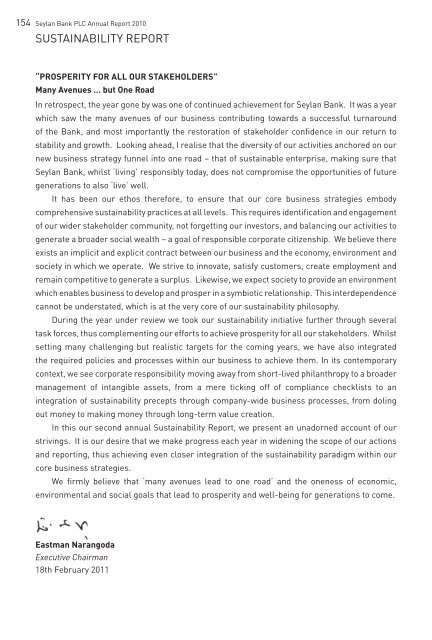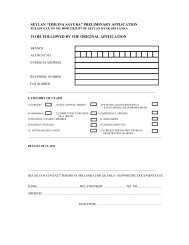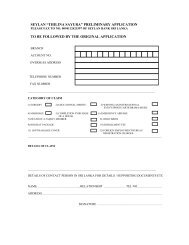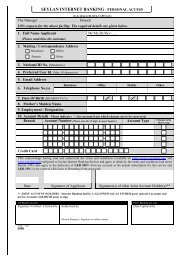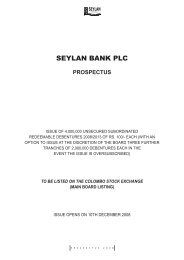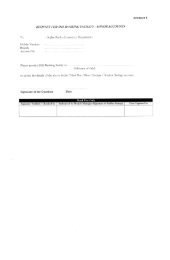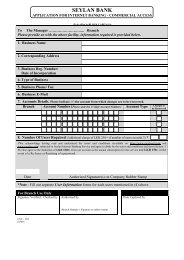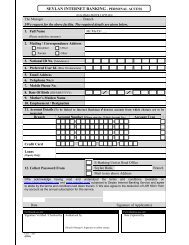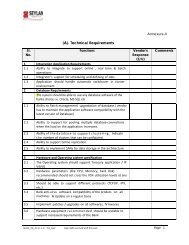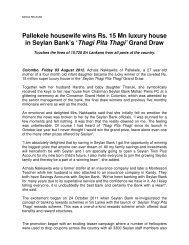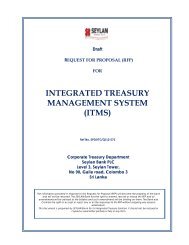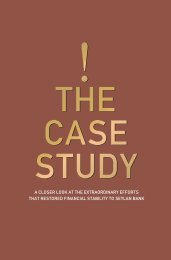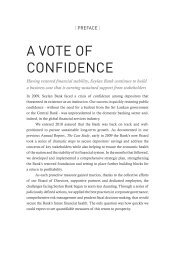SUSTAINABILITY REPORT - Seylan Bank
SUSTAINABILITY REPORT - Seylan Bank
SUSTAINABILITY REPORT - Seylan Bank
Create successful ePaper yourself
Turn your PDF publications into a flip-book with our unique Google optimized e-Paper software.
154<strong>Seylan</strong> <strong>Bank</strong> PLC Annual Report 2010<strong>SUSTAINABILITY</strong> <strong>REPORT</strong>“PROSPERITY FOR ALL OUR STAKEHOLDERS”Many Avenues … but One RoadIn retrospect, the year gone by was one of continued achievement for <strong>Seylan</strong> <strong>Bank</strong>. It was a yearwhich saw the many avenues of our business contributing towards a successful turnaroundof the <strong>Bank</strong>, and most importantly the restoration of stakeholder confidence in our return tostability and growth. Looking ahead, I realise that the diversity of our activities anchored on ournew business strategy funnel into one road – that of sustainable enterprise, making sure that<strong>Seylan</strong> <strong>Bank</strong>, whilst ‘living’ responsibly today, does not compromise the opportunities of futuregenerations to also ‘live’ well.It has been our ethos therefore, to ensure that our core business strategies embodycomprehensive sustainability practices at all levels. This requires identification and engagementof our wider stakeholder community, not forgetting our investors, and balancing our activities togenerate a broader social wealth – a goal of responsible corporate citizenship. We believe thereexists an implicit and explicit contract between our business and the economy, environment andsociety in which we operate. We strive to innovate, satisfy customers, create employment andremain competitive to generate a surplus. Likewise, we expect society to provide an environmentwhich enables business to develop and prosper in a symbiotic relationship. This interdependencecannot be understated, which is at the very core of our sustainability philosophy.During the year under review we took our sustainability initiative further through severaltask forces, thus complementing our efforts to achieve prosperity for all our stakeholders. Whilstsetting many challenging but realistic targets for the coming years, we have also integratedthe required policies and processes within our business to achieve them. In its contemporarycontext, we see corporate responsibility moving away from short-lived philanthropy to a broadermanagement of intangible assets, from a mere ticking off of compliance checklists to anintegration of sustainability precepts through company-wide business processes, from dolingout money to making money through long-term value creation.In this our second annual Sustainability Report, we present an unadorned account of ourstrivings. It is our desire that we make progress each year in widening the scope of our actionsand reporting, thus achieving even closer integration of the sustainability paradigm within ourcore business strategies.We firmly believe that ‘many avenues lead to one road’ and the oneness of economic,environmental and social goals that lead to prosperity and well-being for generations to come.Eastman NarangodaExecutive Chairman18th February 2011
<strong>Seylan</strong> <strong>Bank</strong> PLC Annual Report 2010 155STRATEGY AND ANALYSISContextSustainability reporting is about measuring,disclosing and being accountable to stakeholdersfor the organisation’s economic, environmentaland social performance in the context of its goalof sustainable development. ‘Sustainability’ hererefers to meeting the needs of the present withoutcompromising the ability of future generations tomeet their own needs.In this Sustainability Report we provide abalanced review of our sustainability performanceduring the year under review, measured acrossa range of parameters in relation to the <strong>Bank</strong>’scommitments, strategy and managementapproach.Strategy and Precept<strong>Seylan</strong> <strong>Bank</strong>, as a major player in the financialsector of the country, is committed to sustainabledevelopment as a fundamental business philosophy.In turn, sustainability resides at the very core in theway we design products, deliver financial services,organise the workplace and engage with society.The <strong>Bank</strong> adheres to a set of commitments andstrategies that we detail here, to lend context to ourwider reporting.Commitment to SustainabilityTo comprehensively integrate economic,environmental and social considerations into thecore business strategies and activities, with thelong-term goal of maximising shareholder value.Environmental ProtectionWe are committed to prevent or minimiseenvironmentally and/or socially detrimentalimpacts of client portfolios and as well as the<strong>Bank</strong>’s own operations. This includes continuousreview and improvement of environmental andsocial safeguards of our existing activities thatwere designed previously.Responsibility and AccountabilityThe <strong>Bank</strong> bears responsibility for the environmentaland social impacts of all its transactions. We areaccountable to our stakeholders, and their rightsare protected by law and through the <strong>Bank</strong>’s ownpractices and procedures.Transparency and GovernanceThe <strong>Bank</strong> practices transparency in all its dealings,not only through, regular and transparent disclosuresrelating to financial decisions, but also by beingresponsive to stakeholders’ needs for timely andrelevant information on the <strong>Bank</strong>’s transactions.The <strong>Bank</strong> goes beyond mere compliancerequirements in discharging its corporate governancefunction. In particular, the highest ethical standardsare maintained at all times in all our activities.The <strong>Bank</strong> seeks to progressively improve itsvoluntary Corporate Social Responsibility activitiesinto something more integrated and aligned tosustainable development, as our past experienceshows that some activities did not create the desiredimpact in upgrading the economy, environment orsociety.Key Areas of Impact, Risk and OpportunitiesThe <strong>Bank</strong> uses Sustainability principles as partof its risk management processes for economic,environmental, social and governance practices,at both strategic and operational levels. Duringthe year under review we have been able tocrystallise some key areas that exemplify impact,risk and opportunity within the context of the<strong>Bank</strong>’s operations, which are detailed below:EconomicThe <strong>Bank</strong> identified the following factors thatchallenged business – the global economicmeltdown, crises of confidence, risk aversion,liquidity crunch, interest rate risks, fluctuationsin foreign exchange rates and commodity prices.These challenges however did yield areas ofopportunity for the <strong>Bank</strong>, such as – tapping marketpotential in growing sectors such as SME, housing
<strong>Seylan</strong> <strong>Bank</strong> PLC Annual Report 2010<strong>Seylan</strong> <strong>Bank</strong> PLC Annual Report 2010 157SavingsE-banking<strong>Seylan</strong> Sure: A unique scheme for personal Currentand Savings account holders which providesdefinite returns on special occasions in life!<strong>Seylan</strong> Tikiri Plus: ‘Big account for the little ones’.Internet <strong>Bank</strong>ing: Log on to www.eseylanet.com and access <strong>Seylan</strong> <strong>Bank</strong> Accounts globally,anywhere, anytime.<strong>Seylan</strong> Internet Payment Gateway: Make onlinepayments for goods and services by any Credit orDebit Card through the secure <strong>Seylan</strong> PaymentGateway.Seylaphone: For basic banking functions using afixed line, touch phones or mobile phones.Non-Resident Foreign Currency (NRFC)/ResidentForeign Currency (RFC) Thilina Sayura Accounts:A unique package of cash rewards at life’ssignificant events.Cool Cash: A unique account for the youth of todayaged between 15-25.<strong>Seylan</strong> 2 in 1: A product that combines the best ofboth Current and Savings accounts.<strong>Seylan</strong> Ihalin Ihalata: A savings account whichoffers a high return with unlimited withdrawals.Fixed DepositsSMS <strong>Bank</strong>ing: Access to accounts through any GSM(Mobitel/Dialog/Etisalat/Hutch) phone using SMS.Fee-Based Income/Alternate InvestmentsGlobal Money Transfer Services: Authorised agentfor Global Money Transfers such as MoneyGram,Xpress money, SAMBA Speed Cash, Instant Cash,Ez Remit, AFX Fast Remit and SWIFT; remittancesvia banks and other exchange houses.<strong>Seylan</strong> Gold Heart: Invest and trade in gold, for agolden future.<strong>Seylan</strong> Bancassurance: Personal financialplanning and insuranceMillennium 30: A 30-day Fixed Deposit.<strong>Seylan</strong> Shakthi and <strong>Seylan</strong> 5 Star: 4 year and 5 yearFixed Deposits.<strong>Seylan</strong> Harasara: Senior Citizens’ account scheme,which could be a Current, Savings or Fixed Depositfor customers over 55 years of age.
158<strong>Seylan</strong> <strong>Bank</strong> PLC Annual Report 2010Lending Products<strong>Seylan</strong> Siri Nivasa Housing Loans: Opportunity topurchase a land and construct your dream home,purchase a ready-made house, to put up an extensionto your existing home or renovate your home.Express Housing Loan: A housing loan in4 working days.<strong>Seylan</strong> Smart Lease: Convenient rentals, flexiblerepayment schemes to suit one’s purse.<strong>Seylan</strong> Pawning Service: ‘Cash at an emergency,safety for your gold’ from <strong>Seylan</strong> Pawning.<strong>Seylan</strong> Scholar: A unique higher education loanscheme which provides financial backing to achieveacademic and professional dreams.<strong>Seylan</strong> Ran Salasum: ‘Invest your idle gold with <strong>Seylan</strong><strong>Bank</strong> and receive instant cash to plan your future’.<strong>Seylan</strong> Cards<strong>Seylan</strong> Credit Card: <strong>Seylan</strong> VISA/MasterCard CreditCard with exclusive offers such as free SMS alertfacility, unique Suwa Maga Scheme that looks afterhospital bills, zero interest instalment schemes,travel and medical insurance cover and discounts.<strong>Seylan</strong> Debit Card: <strong>Seylan</strong> VISA/MasterCard DebitCard for purchases at any merchant outlet, towithdraw cash from over 1.6 Mn. ATMs globally orto make purchases at over 20 Mn. merchant outletsglobally. Cardholders save 1% of total purchase valueon a monthly basis, plus partial refund of Debits Tax.<strong>Seylan</strong> VISA Pre-paid Rupee Card: Issued withouthaving to open an account at the <strong>Bank</strong>, for uselocally.<strong>Seylan</strong> VISA Travellers’ Card: An alternative toTraveller’s Cheques, and can be used for purchasesand ATM withdrawals globally.Our MarketsThe <strong>Bank</strong> operates in all nine provinces and most ofthe districts in the country, through its network of95 branches and 27 extension offices. The branchnetwork saw recent expansions in the North andthe East following end of the civil war in 2009.The <strong>Bank</strong> offers a gamut of banking and relatedservices such as accepting deposits, personalbanking, trade financing, off-shore banking,resident and non-resident foreign currencyoperations, travel related services, corporate andretail credit, project financing, lease financing,rural credit, local and international credit cards,telebanking and internet banking facilities, anddealing in Government Securities.
<strong>Seylan</strong> <strong>Bank</strong> PLC Annual Report 2010 159Scale of OperationsAs at 31st December 2010 the total assets ofthe <strong>Bank</strong> was Rs. 149.9 Bn., with total equity ofRs. 12.1 Bn. and a staff strength of 3,622. Duringthe year under review the <strong>Bank</strong> posted a grossincome and profit after tax of Rs. 20.0 Bn. andRs. 1.2 Bn. respectively. More information may befound in the Financial Statements as well as in theTen Year Summary and Summary of PerformanceIndicators given elsewhere in the Annual Report.AwardsThe <strong>Bank</strong> won the Bronze Award in the overall<strong>Bank</strong>ing Sector at the ICASL Awards.Mr. Lalith Withana, Director <strong>Seylan</strong> <strong>Bank</strong> receiving Bronzefor the <strong>Bank</strong>’s Annual Report at the ICASL Annual ReportAwards Ceremony 2010.The <strong>Bank</strong> won the Gold Award for the TurnaroundBrand of the Year at the Brand Excellence Awards2010 of Sri Lanka Institute of Marketing.At the 24th Annual International ARC Awardsheld in New York last September 2010, the <strong>Bank</strong>’sAnnual Report for 2009 won a Gold for its ExecutiveChairman’s Letter, a Bronze in the Non-TraditionalAnnual Reports category, 2 Bronzes for InteriorDesign and Cover Photo Design and an Honours forPhotography.At the League of American CommunicationsProfessionals - Vision Awards for publicationsproduced in 2009, the <strong>Bank</strong>’s Annual Report wonthe Overall Gold Award in the Commercial <strong>Bank</strong>scategory as well as the Gold Award for the MostImproved Annual Report from the Asia Pacific Region.<strong>REPORT</strong> PARAMETERSReport Framework and FrequencyAs in the previous year, we have prepared thisSustainability Report against the Global ReportingInitiative (G3) guidelines. We have also been guidedby the International Federation of Accountants(IFAC) Sustainability Framework.Unless otherwise stated, the period covered bythis Report for the information provided is calendaryear 2010 (which coincides with our financial year).The previous Sustainability Report of the <strong>Bank</strong>covered 2009, which was included in our AnnualReport of that year and released in February 2010.The <strong>Bank</strong> produces these reports annually.Any questions or comments on thisSustainability Report may be directed to theExecutive Director of <strong>Seylan</strong> <strong>Bank</strong> PLC,Mr. R. Nadarajah on his direct Telephone Number2456752, Fax Number 2452597 or e-mail addressnadarajahr@seylan.lk.Mr. Kamal Deshapriya - AGM Marketing receiving theGold Award at the SLIM Brand Excellence Awards -<strong>Seylan</strong> was the ‘Turnaround Brand of the Year 2010’.
160<strong>Seylan</strong> <strong>Bank</strong> PLC Annual Report 2010Scope and CoverageThis Sustainability Report covers topics andindicators that reflect the <strong>Bank</strong>’s most significanteconomic, environmental and social impacts and/or those which would substantively influence theassessment and decisions of our stakeholders.Given the disparate nature (and interests) of variousstakeholders, the <strong>Bank</strong> is compelled to strategicallydefine its key stakeholders to ensure materialityin its engagement and reporting. Accordingly, the<strong>Bank</strong> defines its principal stakeholders as investors,customers, employees and the communities inwhich it operates. This Report provides an overviewof how the <strong>Bank</strong> contributes to the improvement ofeconomic, environmental and social conditions of itskey stakeholders and how it manages such impacts.Further, we declare that this SustainabilityReport is restricted to the activities of <strong>Seylan</strong> <strong>Bank</strong>alone, and does not include any of its subsidiaries.GOVERNANCE, COMMITMENTS ANDENGAGEMENT GOVERNANCEGovernanceCorporate governance, given its critical importance,has been discussed in detail through a separatereport that is an integral part of the <strong>Bank</strong>’s AnnualReport.Sustainability StewardshipOur corporate responsibility mechanism is drivenby a board appointed Sustainability ManagementSubcommittee which formulates strategies in linewith the core business of the <strong>Bank</strong>. The Committeeis assisted by three committees focusing onEconomic, Environmental and Social aspects,which are staffed by senior management personneland volunteers. The Assistant General Manager,Finance-functions as the ‘Sustainability Champion’,and 90 ‘Sustainability Wardens’ comprising <strong>Bank</strong>staff who have volunteered to implement thevarious sustainability initiatives at Branch andRegional level.EnvironmentManagementSub CommitteeBoardSustainability SteeringCommittee of the BoardEconomicManagementSub CommitteeSustainability Wardensfrom BranchesStakeholder EngagementSocialManagementSub CommitteeWell managed stakeholder relationships strengthenbusiness. The converse is also true. Hence, the <strong>Bank</strong>duly considers the identification and the engagementof its various stakeholders as a vital process withinits business operations. Stakeholders are mappedby the level to which they can influence the <strong>Bank</strong>,and also by the level to which they may be influencedby the <strong>Bank</strong>. The <strong>Bank</strong> then targets its engagementstrategy based on materiality.Our main stakeholder groups are:• Investors - shareholders, debenture holders• Customer - depositors, account holders,borrowers, etc.• Employees• Suppliers of goods and services• Correspondent banks – local and international• Regulators• The community in which we operate• Others - business partners, principals, civicsociety, pressure groups, media, industrypeers, competitors.
<strong>Seylan</strong> <strong>Bank</strong> PLC Annual Report 2010 161The frequency and depth of engagement variesdepending on the need, and may range from annualmeetings to ad hoc face to face discussions, fromtargeted communications to impersonal websiteinformation and so on. The table below capturessuch interactions.Stakeholder Current level of Engagement Their Concerns Our ConcernsShareholders,Debenture holders,Rating agencies,Financial analystsCustomers• We connect with every singleshareholder with our Annual Report;the key statements by the ExecutiveChairman and Executive Director arepublished in Sinhala and Tamil.• Quarterly Financial Statements arepublished in English, Sinhala and Tamillanguages in local newspapers andupdated on our website.• An open dialogue is encouraged atthe AGM to enable our shareholdersto clarify issues with our Board ofDirectors.• Press releases are issued frequently,to update all stakeholders on the latestdevelopments within the <strong>Bank</strong>, newproducts, awards and achievements.• E-mail addresses, names and telephonenumbers of Branch Managers areupdated regularly on our website to givedirect accessibility to all our stakeholders.• Shareholders Reward Benefit Schemeto reward loyalty through additionalbenefits• Meetings, discussions, field visits,telephone calls, progress reviews,reports on the internet/hard copies asappropriate, business developmentactivities, road shows and campaignsthrough our branch network.• Qualitative and quantitative surveys andresearch to evaluate the standard ofservices to our customers.Profitability, dividends,<strong>Bank</strong>’s strategies forcost saving, reductionof NPL , managerialchanges, branchexpansion, newproducts, privilegecards and cheque booksInterest rates, loanconditions and terms,quality of employeeinteraction with thecustomer, layout ofpremises and parkingfacilities, facilities forutility and other billspayments, credit cardpayments etc, educatingour customers onvarious bankingservices.Superior value creation,profitability, dividends,interest ratesSuperior value creation,retention, loyalty,excellence in service,minimising transactioncosts
162<strong>Seylan</strong> <strong>Bank</strong> PLC Annual Report 2010Stakeholder Current level of Engagement Their Concerns Our ConcernsEmployees andEmployee UnionsSuppliersCorrespondent <strong>Bank</strong>sRegulators includingCentral <strong>Bank</strong> ofSri Lanka, Departmentof Inland Revenue,Colombo StockExchange, Securitiesand ExchangeCommission ofSri Lanka, Registrar ofCompanies, ExternalAuditorsCommunityOthers: businesspartners, principals,civic society, pressuregroups, media, industrypeers, competitors• Internal and external measurement toolsincluding employee satisfaction surveysand feedbacks• Open door policy at all managementlevels• Annual get-to-gethers• Transparent performance appraisalmethod with three-way dialogue betweenemployee, appraiser and reviewer• Intranet facilities for opencommunication and easy knowledgesharing and knowledge management• Documented HR Policies, availableonline and reiterated during recruitment/promotions• Direct access by Unions to topmanagement including the ExecutiveChairman and the Board at specifiedintervals or as requiredMeetings, phone calls, discussions,press notices, emails and letters,prior registrationRemunerationpackage, staff welfare/benefits, promotions,compliance, marketrisk, policy decisions,managerial changes,business developmentplansProcessing ordersand timely delivery,additional businessMeetings, visits, telephone calls, progress Financial Servicesreviews, reports on Internet and hard copies Regulations andas appropriateagreements, exchangerates, interest ratesRepresentation through associations,meetings, telephone calls, discussions,press releases, e-mails and letters, forms/returns, circulars and similar documents• Corporate Responsibility (CR) activities,training, one-on-one discussions,workshops, sponsorships throughbranch network.• Close interface with SustainabilityWardens at branches countrywide• Sponsorship of national eventsRegular meetings, correspondence,monthly market reports, telephone calls,e-mails, circulars, lobbying as an industryRegulation andDirectives, compliance,governance, labourissues that affectthe well-being ofemployees, public lawsCR matters, assistanceand aid, sponsorshipsand collaborationsBusiness decisions,agreements andprovisions, complianceand governance issues,competitive packagesand ratesRemuneration andrewards, health andsafety, job satisfaction,career development,succession planning,balance betweenpersonal andprofessional lifeSourcing supplierslocally as far aspossible, cost, quality,timely deliveryService, delivery, termsand conditions, costeffectivenessCompliance,relationshipsEmpowering thecommunity throughentrepreneurdevelopment, educationand career developmentprogrammesRelationships,governance, benefits,social responsibility,cost, profitability
<strong>Seylan</strong> <strong>Bank</strong> PLC Annual Report 2010 163In addition, the <strong>Bank</strong> maintains a vibrantmembership in several key associations that arerelevant for matters that arise from the ordinarycourse of business, namely:• Institute of <strong>Bank</strong>ers of Sri Lanka• The Ceylon Chamber of Commerce• International Chamber of Commerce ofSri Lanka• The National Chamber of Commerce ofSri Lanka• Lanka SWIFT User Group• Sri Lanka <strong>Bank</strong>s’ Association (Guarantee)Limited• The Employers’ Federation of Ceylon• Clearing Association of <strong>Bank</strong>ersECONOMIC PERFORMANCEManagement approach to EconomicPerformanceOur Policy<strong>Seylan</strong> <strong>Bank</strong> is committed to delivering sustainableand superior economic value to all its stakeholders.As such, our core activities are structured andmanaged to create economic prosperity throughvalue addition.The Strategic PlanFollowing the events of late 2008 and 2009, the <strong>Bank</strong>set forth on a series of practical steps, including arethinking of policy and strategy in every area. Itsoon yielded positive results as noted in our AnnualReport of 2009. Guided by a comprehensive strategicplan the <strong>Bank</strong> is building a healthy and sustainablefuture for all stakeholders while focusing on threekey elements -Goals: defined and articulated in relation tospecific performance indicators, all of which havebeen incorporated into budgets for successivefinancial years;Business-level strategies: focusing on corebusiness areas of retail banking, corporate banking,customer segmentation and product market strategyand support services.<strong>Seylan</strong> introduced a new corporate programmedesigned to stabilise, simplify and strengthen the <strong>Bank</strong>.A vital part of this is about what matters mostto our customers, since our ultimate success dependson them. In light of this strategy to put the customerfirst, we have started several initiatives, such as -• the introduction of the centralisation processwhich would enhance the quality, delivery andthe process time giving all value added servicesto the customers• meet the financial needs of our customers withthe right balance between the interests of ourcustomers and those of other stakeholders• <strong>Bank</strong> has continuous dialogue with itscustomers to score their experience with<strong>Seylan</strong>. This feedback helps us not only tosolve individual customer problems directly,but also to make general service and productimprovements• The results of the surveys help the <strong>Bank</strong>to improve the service quality at the entirenetwork• This path aims to create a corporate culturewith the products and sales processesconsistently• Apart from our customers, there are manyother groups and communities that wouldbenefit from enhanced levels of financialliteracy. It is part of our social commitment tocontribute to this –• specifically through youth education, and• promoting financial literacy in our homemarkets.See the Community investment chapter in page 168for more information on these initiatives.Strategic Initiatives: including expansion,capital requirements, liquidity, cost structure, riskmanagement image and branding;
164<strong>Seylan</strong> <strong>Bank</strong> PLC Annual Report 2010Core strategies are formulated and discussedat Board meetings and various management forums.Goals and performances are communicated to therespective units and monitored clearly at each level,thus leading to the achievement of bank-wide goals.Leveraging on the solid customer base forfuture growth, the <strong>Bank</strong> remains ‘The <strong>Bank</strong> witha Heart’, but at the same time is ready to explorenew ways to provide a more responsive and flexibleservice that were hallmarks of its strong brand.As reported last year, following strategicconsultations, the <strong>Bank</strong> adopted new vision:‘To be the leading financial solutions providerthat delivers exceptional value to stakeholders’.Our aspirations are reflected in the missionstatement:“To exceed customer expectations byproviding competitively priced superior servicesthrough speedy and multiple delivery channels,whilst rewarding staff through recognition andempowerment; being a responsible corporatecitizen; adopting environment-friendly practicesand adding superior value to shareholders”.Economic Performance IndicatorsWhilst the economic and financial performance ofthe <strong>Bank</strong> is discussed at length elsewhere in thisAnnual report, we give below the economic impactsof our activities across key stakeholder segments.Value AdditionValue added is the amount of wealth created byproviding banking and other related services lessthe cost of providing such services. During the yearthe <strong>Bank</strong> generated a total financial value additionof Rs. 6,529 Mn. (2009: Rs. 4,663 Mn.), distributedas follows:• Retained for future expansion Rs. 1,721 Mn.• Paid to capital providers Rs. 257 Mn.• Shared with our employees Rs. 2,887 Mn.• For Government andnation buildingRs. 1,664 Mn.Our Tissamaharama Branch with assistance from CBSLand the Department of Agriculture held a One Day TrainingProgramme for over 200 farmers and produce buyers of theHambantota and Moneragala Districts covering subjects suchas the Government’s agricultural credit schemes, post harvesttechnology and recommended practice for usage of pesticidesand fertilizer.
<strong>Seylan</strong> <strong>Bank</strong> PLC Annual Report 2010 165Financial Value Added Statement2010 2009(Restated)Rs. ’000 Rs. ’000Value AddedIncome Earned by Providing <strong>Bank</strong>ing Services 18,936,970 22,496,007Cost of Services (11,921,386) (16,308,349)Value Added by <strong>Bank</strong>ing Services 7,015,584 6,187,658Non-<strong>Bank</strong>ing Income 1,095,507 658,522Provision for Loan Losses (1,581,842) (2,183,132)6,529,249 4,663,0482010 2009(Restated)Rs. ’000 Rs. ’000 % Rs. ’000 Rs. ’000 %Value AllocatedTo EmployeesSalaries, Wages and Other Benefits 2,886,626 44.21 2,342,563 50.24To Providers of CapitalDividends to Shareholders 257,120 3.94 133,018 2.85To GovernmentIncome Tax 768,653 349,271Stamp Duty 12,238 63,007VAT on Financial Services 857,240 561,440VAT and Debits Tax 25,697 1,663,828 25.48 17,066 990,784 21.25To Expansion and GrowthSurplus/(Deficit) 971,861 410,283Depreciation 749,814 1,721,675 26.37 786,400 1,196,683 25.666,529,249 100.00 4,663,048 100.00
166<strong>Seylan</strong> <strong>Bank</strong> PLC Annual Report 2010Economic Value Addition (EVA)The <strong>Bank</strong> adopts EVA as a measurement ofprofitability in order to deliver a superior economicvalue to all our stakeholders. EVA created duringthe last five years is tabulated below.Economic Value Added StatementEquity2010 2009 2008 2007 2006Rs. ’000 Rs. ’000 Rs. ’000 Rs. ’000 Rs. ’000Shareholders’ Funds 12,097,025 10,570,972 7,020,011 7,036,235 6,368,278Add: Accumulated Provision for Loan Losses 6,287,479 6,466,008 6,560,266 4,972,226 4,558,565Earnings18,384,504 17,036,980 13,580,277 12,008,461 10,926,843Profit Attributable to Shareholders 1,228,981 543,301 155,241 923,189 888,068Add: Provision for Loan Losses 1,581,842 2,183,132 2,467,187 1,365,075 1,684,495Less: Direct Write Offs (10,851) (18,687) (81,611) (23,999) (44,979)2,799,972 2,707,746 2,540,817 2,264,265 2.527,584Economic Cost % (12 months averageTreasury Bill rate plus 2% Risk Premium) 10.58% 14.93% 20.91% 18.60% 12.98%Economic Cost 1,873,796 2,285,578 2,675,302 2,132,983 1,286,313Economic Value Addition 926,176 422,168 (134,485) 131,282 1,241,271
<strong>Seylan</strong> <strong>Bank</strong> PLC Annual Report 2010 167Sources & Utilisation of Income2010 2009 2008 2007 2006Rs. ’000 Rs. ’000 Rs. ’000 Rs. ’000 Rs. ’000SOURCES OF INCOMEInterest 16,596,094 20,708,034 21,552,070 17,806,815 14,123,852Exchange 403,066 521,388 670,731 603,824 600,899Fee and Commission 1,427,046 1,274,251 1,801,826 1,465,027 1,332,192Dividend 6,503 5,199 223,295 21,418 22,192Other 1,599,768 645,657 998,287 1,182,801 1,104,346Total 20,032,477 23,154,529 25,246,209 21,079,885 17,183,481UTILISATION OF INCOMEEmployeesSalaries & Other Payments 2,886,626 2,342,563 3,361,212 3,173,560 2,557,072SuppliersInterest Paid 8,529,007 13,492,053 14,361,452 11,022,689 7,994,959Other Expenses 5,466,915 5,652,810 7,007,501 4,798,290 4,530,96913,995,922 19,144,863 21,368,953 15,820,979 12,525,928Net Income before GovernmentTaxes and Levies 3,149,929 1,667,103 516,044 2,085,346 2,100,481GovernmentIncome Tax/SRL/NBT/VAT/DT 1,663,828 990,784 360,803 1,162,157 1,212,413ShareholdersDividend 257,120 133,018 255,900 255,232 337,196Retained Profits 1,228,981 543,301 (100,659) 667,957 550,872Total 20,032,477 23,154,529 25,246,209 21,079,885 17,183,481
168<strong>Seylan</strong> <strong>Bank</strong> PLC Annual Report 2010Value of Community Investments<strong>Bank</strong> actively participated in three importantcommunity development schemes during the year,with both long-term and short-term investments.Project investmentsValue(Rs. Mn.)Rural Educational Development 1.4Health Care Assistance 0.2Welfare Schemes and assistance formembers in Community Service 1.5Please refer pages 52 and 53 for otherCommunity Related Investments.The <strong>Bank</strong> makes a donation to the National Institute ofMental Health towards the upliftment of the mental healthand well-being of female patients at Mulleriyawaexport business that are highly vulnerable to climatechanges , any adverse climate conditions couldindirectly affect the performance of the <strong>Bank</strong> due todefaults by customers. Likewise, loans to businessesengaged in the leisure sector, tourism and alliedservices and trade financing are also exposed to therisk from unfavourable climatic conditions.Details of the sector wise exposure is given asa note to the financial reporting on page 261.Coverage of the <strong>Bank</strong>’s Benefit Plans (EC 3and EC 5)Retirement Gratuity PlanThe <strong>Bank</strong> operates a retirement gratuity (benefitplan) for its employees as required under theGratuity Act No 12 of 1983. The <strong>Bank</strong> has dulycarried out the actuarial valuation on theseretirement benefit obligations as at the year endand the <strong>Bank</strong>’s actuary has used the projected unitcredit method as prescribed in Sri Lanka AccountingStandard 16. on Employee Benefit for the valuation.The required provision was made to maintain thevalue of the assets in line with the present valueof such obligations. Details and disclosure on thesaid benefit plan is given in the Financial Reportssection of the Annual Report.Contributory Benefit PlansThe <strong>Bank</strong> makes contributions to two types of plansfor its employees, namely:• Employees Provident Fund (EPF), and• Employees Trust Fund (ETF)More details on these schemes are given inthe Financial Reports section of the Annual Report.Compensation and Benefits StrategyDonation of the ‘Name Board’ to Base Hospital - Horana byHorana Branch.Impact of Climate Change (EC2)The <strong>Bank</strong> is not directly exposed to risk arising fromclimate change. However due to the fact that itprovides financial accommodation to customersengaged in industries such as agriculture, fisheries,The wage policy of the <strong>Bank</strong> is not based onCollective Bargaining Agreements at present.Remunerations are based on the market surveyscarried out by the <strong>Bank</strong> at given intervals whichindicate the highest and lowest range of wagestructures in the industry.
<strong>Seylan</strong> <strong>Bank</strong> PLC Annual Report 2010 169Since there is no regulation in place underthe Shop and Office Employees’ Act indicating theminimum wage applicable to employees coveredunder such Act, measures such as continuousdialogue between and among employee unions,corporate peers and labour authorities allowthe <strong>Bank</strong> to keep abreast of current trends andpolicies pertaining to wage practices in the bankingindustry.As a concerned employer, the <strong>Bank</strong> identifiesthe hardships that an employee has to undergowhen working in different locations under differentworking and living conditions. During the yearunder review the <strong>Bank</strong> increased the amountpayable as ‘Difficult Station Allowance’ and alsoidentified more branches as Difficult Stations tobenefit the staff attached to such branches.<strong>Seylan</strong> <strong>Bank</strong> is an equal opportunity employeradopting a market based remuneration regime,on par with the rest of the industry. We take allstatutory obligations seriously and observe themdiligently. The table below gives an analysis of theremuneration and benefits enjoyed by employeesover the past five years.Total Employee Remuneration and BenefitsStaff Benefits 2010 2009 2008 2007 2006Rs. ‘000 Rs. ‘000 Rs. ‘000 Rs. ‘000 Rs. ‘000Staff SalariesBasic Salary 1,864,989 1,934,286 1,972,391 1,570,027 1,280,220EPF 12% 223,591 229,342 235,049 192,302 158,457ETF 3% 55,997 57,306 58,719 48,101 39,771Total 2,144,577 2,220,934 2,266,159 1,810,430 1,478,448Other BenefitsHoliday Pay 72,815 76,600 70,618 60,542 47,270Medical 58,462 56,713 58,109 60,566 28,208Bonus 210,752 62,842 313,642 263,958 212,054Insurance 64,026 37,951 66,785 48,390 35,324Training 5,449 5,511 12,957 20,171 18,947Welfare 58,729 64,454 44,843 40,112 17,584Other Allowances/Benefits 303,879 (139,750) 572,601 497,554 419,174774,112 164,321 1,139,555 991,293 778,561Total Benefits 2,918,689 2,385,255 3,405,714 2,801,723 2,257,009Total No. of Staff 3,622 3,733 3,923 3,871 3,934Average benefits per Employee 805.82 638.96 868.14 723.77 573.72
170<strong>Seylan</strong> <strong>Bank</strong> PLC Annual Report 2010Significant Financial Assistance Received fromthe Government (EC4)<strong>Bank</strong> receives financial assistance from Government/donor agencies to provide loans to beneficiariesunder various refinance schemes and the details ofthese schemes were as follows.Facilities Granted under Refinance SchemesRefinance Scheme Terms and the Donor Sector EligibleNo. of LoansGranted as at31.12.2010Cumulative Amountof Loans Granted asat 31.12.2010Rs. Mn.Post Tsunami Line of 100% Refinanced byCredit (EIB) Contract A European Investment<strong>Bank</strong>Construction SectorDevelopment Project(CSDP)Awakening NorthLoan SchemeEastern ProvinceSpecial Loan Scheme‘Saubagya’ TheProsperity LoanSchemeKapruka AyojanaCredit Scheme100% Refinanced byAgence Francaise deDevelopment90% Refinancedby Government ofSri Lanka100% Refinancedby Government ofSri Lanka100% Refinancedby Government ofSri Lanka100% Refinanced byCoconut CultivationBoardPrivate sector enterprisesdirectly or indirectly affected byTsunami.Construction and public worksector in all areas of postTsunami reconstruction work.Any legally accepted incomegenerating activities in theNorthern province.Any legally accepted incomegenerating activities in theEastern province.Micro, Small and Medium scaleenterpriseSmall and Medium-termcoconut cultivation.4 25.25 95.0186 30.395 16.613 3.19 2.5Facilities granted under Interest Subsidy SchemesInterest Subsidy Schemes Terms and the Donor Sector EligibleNo. of LoansGranted as at31.12.2010Cumulative Amountof Loans Granted asat 31.12.2010Rs. Mn.New ComprehensiveRural Credit Scheme8% interest subsidyfrom Central <strong>Bank</strong> ofSri LankaSmall Scale Farmers forcultivation and produce buyersunder forward sales contracts. 1,045 307.5Suppliers of Goods and Services (EC6)Our suppliers and service providers are identifiedthrough established tender and procurementprocedures. The <strong>Bank</strong> also makes all possibleattempts to select locally based suppliers and serviceproviders from the vicinity of our branches especiallyfor repairs, maintenance, janitorial services etc.Stationery, which is our main expense item onmaterials, is purchased through the local suppliers,while proprietary consumables are procured fromauthorised agents.
<strong>Seylan</strong> <strong>Bank</strong> PLC Annual Report 2010 171Procurements made by Branches from Suppliersin the VicinityServices/PurchasesAmount (Rs.Mn.)Tea /Coffee 16.8Lunch 45.3Supply of Foliage Plants 2.2Fish Tank Maintenance 2.1Janitorial Service 26.6Stationery 4.3Repairs/Maintenance 7.1Local Hiring (EC7)As mentioned previously recruitment has beencurtailed to a greater extent. However, during the yearunder review the <strong>Bank</strong> recruited a few number of staffmembers in locations such as Jaffna, Trincomaleeand Batticaloa, for the branches that were opened inthe North and East Regions. Recruitments are madeafter a placement test and interviews.Placement of employees at various locationsof operations are made after due consideration ofthe employee’s place of residence and the distancerequired to be travelled. However, this considerationcan be overridden by the exigencies of the business.Age Analysis of EmployeesAgeCorporateManagementChiefManagers/SeniorManagersManagers/AssistantManagersExecutives<strong>Bank</strong>ingAssistants/Sub Officers Others TotalBelow 20 Years – – – – 8 – 820 to 30 Years – 1 1 10 1,237 12 1,26130 to 40 Years 5 7 131 750 656 165 1,71440 to 50 Years 15 56 148 157 79 89 544Above 50 20 26 23 15 4 7 95Total Employees 40 90 303 932 1,984 273 3,622Service Analysis of EmployeesServiceCorporateManagementChiefManagers/SeniorManagersManagers/AssistantManagersExecutives<strong>Bank</strong>ingAssistants/Sub Officers Others TotalBelow 5 Years 10 5 16 53 1,183 33 1,3005 to 10 Years 3 2 14 44 334 50 44710 to 15 Years 5 8 48 435 422 107 1,02515 to 20 Years 9 59 194 396 45 73 776More than 20 13 16 31 4 0 10 74Total Employees 40 90 303 932 1,984 273 3,622All managerial staff is hired from the local community.
172<strong>Seylan</strong> <strong>Bank</strong> PLC Annual Report 2010Infrastructure Investments and Services forPublic Benefit (EC8 and EC9)During the year the <strong>Bank</strong> funded a number ofprojects to enhance the prosperity of several sectorsin rural areas. These covered rural infrastructuredevelopment, livelihood improvement, healthimprovement, poverty alleviation etc., as shown inthe following table.Funding of Infrastructure DevelopmentType of ProjectNo. of ProjectsTotal Funding(Rs. Mn.)No. of New EmploymentGenerated with ourAssistanceTransport 42 83.1 146Educational Services 3 0.6 3Health Development 6 1.2 13Construction 1 1.2 2Total 52 86.1 164A Tree Planting Campaign at Ceylinco House BranchENVIRONMENTAL PERFORMANCEManagement Approach... Towards aProtected EnvironmentOur PolicyWe have a long standing commitment to minimisingboth the direct and indirect impacts on our environmentarising from our business activities, whilst at the sametime doing everything we can to protect and replenishthe natural resources around us. Accordingly, the <strong>Bank</strong>ensures that not only are its products and servicescompliant with applicable environmental standards,but also takes into account the environmental andsocial impact of the projects it supports during thenormal course of business.Environmental Performance IndicatorsMaterials (EN1 and EN2)Stationery accounts for the largest share of materialsconsumed by the <strong>Bank</strong> for its day to day operations,and we are conscious that every kilogram of paperreused or recycled has a beneficial impact in termsof reducing tree felling, saving landfill space andreducing pollution. Several conservation measuresare therefore in place, such as reducing the amountused by encouraging paperless procedures andmaking printouts only when really necessary,reusing paper that has been printed on one sideonly for printing documents that are requiredin draft form, and recycling used paper thoughregistered procurers. The <strong>Bank</strong> just took anotherstep forward by offering its shareholders the optionof choosing an electronic CD version of this AnnualReport instead of the usual printed version.Recycling of Waste PaperWe have a comprehensive paper recyclingprogramme in operation. It is common knowledgethat every kilogram of paper recycled has abeneficial impact in terms of reducing tree felling,saving landfill space and reduces pollution.During the year under review the <strong>Bank</strong> channeled57,860 kg of waste paper to a third party recycler,Neptune Papers (Pvt) Limited.
<strong>Seylan</strong> <strong>Bank</strong> PLC Annual Report 2010 173Total collected and shredded from 2007 - 2010:2007 2008 2009 2010 Total28,590 kg 16,750 kg 14,750 kg 57,860 kg 117,950 kgIt is significant to note that the recycling of thisquantity of paper has made a positive impact on theenvironment by saving approximately 980 Trees,1.8 Mn. litres of Water 230,000 Kwh of Electricityand 101,000 litres of Oil and 170 cubic metres oflandfill.Furthermore, redundant/unserviceable electroniccomponents are channeled to a responsible local thirdparty for disposal, while savings have been achievedthrough the use of recharged toner cartridges.
174<strong>Seylan</strong> <strong>Bank</strong> PLC Annual Report 2010Energy (EN3 to EN7)Electricity is the largest source of direct energyconsumed by the <strong>Bank</strong>. Hence, several measures arein place to minimise waste, while not compromisingon the quality of ventilation, air conditioning andlighting, which are the main points of consumption.A comparison of units consumed/ value thereof isgiven below for years 2009 and 2010.Units ConsumedValue (Rs.)2010 2009 2010 2009HeadOffice 3,239,430 3,320,669 33,463,358 35,576,494Branches 6,122,877 6,231,375 179,337,858 175,336,420Total 9,362,307 9,552,044 212,801,216 210,912,914Indirect energy consumption has also beenreduced through the various cost saving initiativesthat are in place, such as the pooling of transportvehicles, regional cash transport services etc.However, quantification has not been made dueto the complex nature of the operations. The <strong>Bank</strong>also has several energy conservation measures inplace, such as:• Central air conditioning facilities at both headoffice and branches are limited to the officehours - 8.30 a.m. to 5.00 p.m.• The number of lifts in operation are reducedduring non-peak hours and holidays.• Energy saving bulbs are used throughout the<strong>Bank</strong>, including LEDs where appropriate• Lights are switched off and computers shutdown when staff leave the premises. All staffhave been educated on this requirement.Water (EN 8)Details of water consumption at the Head Officeand Branches are given below.Units2010 2009Unit/EmployeeUnitsUnit/EmployeeIt has been identified that there is an increasein units consumed with regard to water consumptionduring the year along with expansion of network. Inlight of this the <strong>Bank</strong> is now taking steps to createawareness amongst the staff about the importanceof using water with minimum wastage.Environmental Compliance (EN28)The <strong>Bank</strong> was not subject to any sanctions or finesarising from non-compliance with environmentallaws and regulations.SOCIAL PERFORMANCEManagement ApproachOur policyWe believe that the key to our success and competitiveadvantage is our unique team commitment tocontinuous improvement and results. We arecommitted to encouraging our team members toenhance their skills; map out their careers and growboth personally and professionally. We also ensure thatthe <strong>Bank</strong> espouses and practices an equal opportunityapproach which fosters high levels of motivation.Goals and Performance and Organization’sResponsibilityThe <strong>Bank</strong> designs its HR Policies based on strategicbusiness needs and develops its human resourcesto go that extra mile to achieve organisationalgoals. The <strong>Bank</strong>’s HR Division is headed by aDeputy General Manager and he is assisted by anAssistant General Manager and the Heads of Units.The <strong>Bank</strong>’s robust training and career developmentregime has enabled it to retain the best of talentand also to recognise the most competent peopleand build a HR pipeline to drive business expansionplans. Further during the year, the <strong>Bank</strong> tookseveral measures to create a performance drivenwork culture by establishing KPIs.Head Office 34,633 29.1 27,227 23.1Branches 55,713 22.9 55,541 21.8Total/Average 90,346 24.9 82,768 22.2
<strong>Seylan</strong> <strong>Bank</strong> PLC Annual Report 2010 175Employment Performance IndicatorsWorkforce Analysed by Employment Type andRegion (LA1)The total workforce of the <strong>Bank</strong> as at 31st December2010 was 3,622, analysed as follows.Type of Employment Number %Full Time 3,622 100Part Time – –Total 3,622 100Type of Contract Number %Permanent 3,543 97.8Contract 51 1.4Trainee 28 0.8Total 3,622 100Table based on Geographic BreakdownProvinceNo. ofBranchesNo. ofEmployeesCentral 9 231Eastern 5 134Northern 5 92North Central 5 108North Western 5 125Sabaragamuwa 8 172Southern 7 162Uva 2 44Western* 49 2,554Total 95 3,622* Including Head Office StaffEmployee Turnover (LA2)During the year under review there were 127resignations and another 61 persons left the <strong>Bank</strong>due to retirement or end of contract. The detailsare given below, analysed by age group, gender andregion.Staff Turnover by Age Group and GenderAge Group Number Leaving % of TotalMale Female StaffBelow 20 – – –>20 to 30 39 24 1.74>30 to 40 43 9 1.44>40 to 50 10 2 .33Above 50 – – –Total 92 35 3.51Staff Turnover by RegionProvinceNumberLeaving% of TotalStaffCentral 13 .36Eastern 5 .14Northern – –North Central 2 .06North Western 3 .08Sabaragamuwa 3 .08Southern 7 .19Uva 4 .11Western 90 2.49Total 127 3.51Benefits Analysed by Type of Employment (LA3)Employees who are full-time and confirmed inservice enjoy the most number of benefits offeredby the <strong>Bank</strong>, which again varies depending on one’sgrade. They are subject to an annual performanceappraisal, which provides a basis for calculation ofincentives. In addition, they are entitled to bonuses,holiday allowances, medical and insurance benefits,concessionary staff loans, holiday bungalow facilities,etc. In general, those on part-time or probation arenot entitled to these benefits.Labour/Management RelationsCollective Bargaining Agreements (LA4)The <strong>Bank</strong> has always maintained an effectiveindustrial relations policy and a close and constantdialogue with staff at all levels. Through the staffsuggestion scheme, team members are givenample opportunities to contribute to decisionmaking process and innovations in the <strong>Bank</strong>. Infact, very productive staff suggestions received in2010 have paved the way for the implementationof a number of new projects aimed at processsimplification and centralization.The two employees’ unions in our <strong>Bank</strong> havecontinued to interact and build a spirit of cooperationand commonality of purpose.Minimum Period of Notice to Employees (LA 5)The <strong>Bank</strong> does not have a policy at present on theminimum period of notice for operational changes.Hence, operational changes are usually made in
176<strong>Seylan</strong> <strong>Bank</strong> PLC Annual Report 2010line with norms prevailing in the industry, andafter consultative meetings with those affected.All staff members are informed of such changesthrough internal circulars that are also posted onthe intranet. In addition, training and awarenesssessions are conducted to educate those affected.Occupational Health and SafetyHealth and Safety Awareness (LA6)Creating a safe and secure work environment isstrictly addressed, despite a lack of formalisedmanagement-employee committees. The primaryfocus is on providing a high level of internal securitythrough a dedicated controller (intelligence andsecurity), adopting clean housekeeping practices,providing training on the proper use of appliances andequipment etc. while adopting applicable industrynorms for facilities such as lighting and ventilation.The <strong>Bank</strong> adopts an inclusive approach by welcomingsuggestions and comments from employees andrelated parties regarding these aspects.Illness and Accidents (LA7)There were no work related accidents or incidenceof occupational disease reported during the yearunder review.CategoryDisease Control Programmes (LA8)The <strong>Bank</strong> does not have formalised programmesfor the prevention of serious diseases. However, acomprehensive medical screening of employees iscarried out at entry level.Health and Safety and Trade Unions (LA 9)The <strong>Bank</strong> has a comprehensive surgical andhospitalisation insurance package and a medicalscheme, which have been implemented for severalyears with changes made from time to time based onsuggestions and recommendations from employeesand trade unions.Training and EducationTraining Hours by Employee Category(LA10 and LA11)The <strong>Bank</strong> looks at training as an investment, notonly to enhance productivity but also to motivatestaff through job enrichment and better careerprospects. Given below are the key measures ofour training efforts during the year under review.NumberEmployedNumberTrained*AverageMan-Hours ofTraining perCategoryCorporate Management 40 69 15.42Chief/Senior and other Managers 393 725 14.25Executives 932 1,442 15.68<strong>Bank</strong>ing Assistants/<strong>Bank</strong>ing Trainees 1,984 3,888 16.90Others 273 906 11.22* Exceeds number employed due to a staff member participating in more than 1 programme.The table below summarises the topics covered by these training programmes.ProgrammeNo. ofProgrammesNo. ofParticipantsMan-HoursGeneral <strong>Bank</strong>ing Practices 70 2,626 20,090Professional Developments 08 264 2,376Communication and Negotiation Skills 04 258 3,000Marketing and Marketing Communications 18 235 1,876HR Management and Staff Development 10 83 1,022Project Management 1 6 48Compliance and Specialised Areas 73 1,247 9,995General and Personal Development 57 2,311 19,022Total 241 7,030 57,429
<strong>Seylan</strong> <strong>Bank</strong> PLC Annual Report 2010 177Performance and Career DevelopmentReviews (LA12)As noted in previous sections of this Report, all staffmembers receive regular performance and careerdevelopment reviews, which are an integral part ofthe <strong>Bank</strong>’s Human Resource policy.Diversity and OpportunityComposition of Governance Bodies (LA13)The composition of the <strong>Bank</strong>’s governance bodiesanalysed by gender and age group is given below.No. of No. ofAge GroupGovernance BodyMales FemalesUnder 30 30-50 Over 50Board of Directors 10 – – 4 6Board Audit Committee 3 – – 1 2Board Integrated Risk ManagementCommittee 3 – – 2 1Board Nomination Committee 4 – – 2 2ALCO 9 2 – 3 8Management Committee 20 7 – 16 11Procurement Committee 5 2 – 6 1Employees Provident Fund Committee 6 2 – 5 3Basic Salary Analysed by Gender (LA14)The <strong>Bank</strong> does not have different salary scales for menand women, and as noted previously, remunerationis determined through a transparent performanceevaluation programme. The table below captures thebasic pay during the year under review analysed bymale (M) and female (F).Total BasicSalaryTotal BasicSalary toWomen% to the TotalBasic Salary inthe GradeTotal BasicSalary to MenCategory Rs. ‘000 Rs. ‘000 Rs. ‘000% to the TotalBasic Salary inthe GradeSenior Management 121,553 19,304 15.88 102,249 84.12Managers 454,777 146,218 32.15 308,559 67.85Executives 513,101 246,011 47.95 267,090 52.05<strong>Bank</strong>ing Assistants 645,461 275,050 42.61 370,411 57.39Others 130,097 12,428 9.55 117,669 90.45Total 1,864,989 699,011 37.48 1,165,978 62.52
178<strong>Seylan</strong> <strong>Bank</strong> PLC Annual Report 2010Human RightsOur Policy<strong>Seylan</strong> <strong>Bank</strong> is committed to uphold the HumanRights Standards enshrined in the UniversalDeclaration of Human Rights and the Conventionsof the International Labour Organization (ILO).These cover the elimination of all forms ofcompulsory labour; the effective abolition of childlabour; and the elimination of discrimination withrespect to employment.Goals and Performance and Organization’sResponsibilityThe <strong>Bank</strong>’s employment practices enshrine humanrights values and practices such as the abhorrenceof compulsory labour, abiding by stipulatedminimum working age and working hours limits,setting exemplary standards of health and safetyin the workplace and prohibiting discrimination etc.Interacting with theCommunity as a SociallyResponsible citizenthrough Donationsand grantsImprovingCommunity andEnvironment throughVolunteer ProjectsTransformativeSustainability throughbuilding Prosperity forall StakeholdersThe staff attached to our Human ResourceDepartment undergo periodic training programmeson matters related to Human Rights.Non-Discrimination (HR 4)<strong>Bank</strong> had no incidents of discrimination reportedduring the period under review.Child Labour (HR 6)The <strong>Bank</strong> has a zero tolerance towards child labour,and ensures full compliance with all the provisionsand laws of the country at the time of recruitment.The <strong>Bank</strong> rewards 13-year old Saluk Ravisi Hettiarachchiof Taxila Central College who represented Sri Lanka at theInternational Science and Mathematics Competition winningSilver in 2009 and Bronze in 2010.
<strong>Seylan</strong> <strong>Bank</strong> PLC Annual Report 2010 179Security Practices (HR 8)The <strong>Bank</strong> has a laid down procedure on the securitypractices to be adopted concerning human rights,which have been communicated to all the levels ofsecurity officers. Periodic checks and awarenessprogrammes are also conducted by the Controllerof Intelligence and Security of the <strong>Bank</strong> to ensurecompliance.Future PlansThe <strong>Bank</strong> has selected Dewamulla village inBulathsinhala Electorate to start home gardening,microfinancing and, community work andenvironmental protection measures.Access Points in Low-populated and DisadvantagedAreas FS13CommunityOur Policy<strong>Seylan</strong> <strong>Bank</strong> is committed to communitydevelopment and believes it to be a process ofempowering individuals and groups to improvetheir livelihood within their community as opposedto fostering dependency. The <strong>Bank</strong> seeks toprogressively shift its voluntary CSR activity into therealm of meaningful sustainability.Goals and Performance and the Organisation’sResponsibilityThe <strong>Bank</strong> considers CSR initiatives to be part andparcel of it’s core banking business and operationsand therefore strives to develop a suitable existencefor all stakeholders. Our initiatives focuses on theeconomic prosperity, growth of community andupgrading the country at large.Scope and Effectiveness of CommunityDevelopment Programmes (SO 1)MicrofinancingThe <strong>Bank</strong>’s micro finance schemes continue tocontribute towards the improvement of livelihoodsof small scale entrepreneurs, particularly wholive in areas with limited resources. During theyear under review the <strong>Bank</strong> granted over 1,117microfinance loans amounting to Rs. 74.3 Mn, fora range of activities including animal husbandry,post-harvest processing of agricultural products,construction, cultivation of fruits, exotic plants, ricemilling, purchase of farm machinery, as well as themanufacture of garments and footwear.Opening of our Kilinochchi Branch on 7th June 2010<strong>Bank</strong> opened new branches in areas that are lesspopulated as well as those that are recoveringfrom the cessation of the war in the country, suchas Mannar and Kilinochchi. Details of branches/customer service points that were opened duringthe year under review are listed below:BranchesExtensionOfficesKillinochchi SiyabalanduwaATM’sNawalapitiyaMannar Kataragama R.A. De Mel MawathaDeal Place, Col. 3KillinochchiBatticaloaNegomboKataragamaMannarDam Street
180<strong>Seylan</strong> <strong>Bank</strong> PLC Annual Report 2010Anti-corruption Policies and ProceduresRisks Related to Corruption (SO2 & SO3)The <strong>Bank</strong> regularly conducts training programmesto make its staff aware of the threats and issuesarising from fraud and corruption. Details of suchprogrammes conducted during the year are givenbelow.Type of TrainingNo. ofProgrammesNo. ofParticipantsNo. ofMan-HoursGeneral <strong>Bank</strong>ing Practices 70 2,626 20,090Anti-Money-Laundering 2 5 40Anti-money-laundering – Know Your Customer 3 60 120System Security 6 32 388Accounting and Auditing 22 708 4,775Total 103 3,431 25,413Public Policy and Society (SO5 and SO6)The <strong>Bank</strong> submitted its proposals to Governmentfor consideration when formulating the nationalBudget for 2011. This has been a regular annualfeature.<strong>Bank</strong> has carried out its transactions in theordinary course of the business and on an armslength basis; no contributions were made topolitical parties or politicians.Anti-competitive Behaviour (SO7)The <strong>Bank</strong> did not encounter any legal action forany anti-competitive behaviour during the year2010. The <strong>Bank</strong> always complies with the laws andregulations of the country in handling marketingcampaigns including the display of banners,conduct of road shows, branding etc.Compliance with Laws and Regulations (SO8)The <strong>Bank</strong> was not subject to any fines or sanctionsfor non-compliance with laws and regulationsduring the year under review. The <strong>Bank</strong> continuesto comply with all applicable laws and regulations,and as a monitoring tool, monthly compliancereports are tabled at Board meetings.Product ResponsibilityAt <strong>Seylan</strong> <strong>Bank</strong>, product responsibility is a sine quanon in building a sustainable business venture. Thepursuit of optimum levels of product responsibilityforms an integral component of the social parameterin our Triple Bottom Line Reporting regime.Our Policy/ResponsibilityThe <strong>Bank</strong> takes great care to ensure that everyproduct and service we offer is relevant, meets andexceeds customer expectations, is non-exploitativeand embodies the optimum levels of clarity andtransparency in their inherent features, presentationand advertisement and other such like areas thatimpact our customers and the wider stakeholdercommunity. The <strong>Bank</strong> exercises strict control toensure that there is no misrepresentation of factsin terms of its operations, products and services.Customer Health and Safety (PR1)By virtue of the specific nature of the businessof the <strong>Bank</strong>, customer health and safety cannotbe directly linked with our products and services.However, all possible actions are taken to improvecustomer services which would help to mitigateany indirect health and safety issues such as stressor frustration by providing clearly understandableand regular, on-time statements, on-line access,e-banking facilities, trained tellers, countrywideaccess points etc.
<strong>Seylan</strong> <strong>Bank</strong> PLC Annual Report 2010 181Product and Service Labelling and MarketingCommunications (PR3 to PR7)The <strong>Bank</strong> always discloses all relevant informationregarding its products and services to enablecustomers to make informed and considereddecisions. Likewise, the <strong>Bank</strong> carries out itsmarketing campaigns in an ethical and sociallyresponsible manner so as not to mislead people.During 2010 the <strong>Bank</strong> initiated a survey/study through an external specialised company toevaluate and improve customer satisfaction andits level of service. The <strong>Bank</strong> also carried out anevaluation of its effectivity of its sales platform andstaff by analysing certain skills such as:• Reliability, responsiveness at each customertouch point• Service excellence• Knowledge of key products, productmodifications, promotions of staff• Compliance with company standards relatingto service and branding• Overall friendliness and cooperativeness• Branch image and accessCompliance with Product Responsibility(PR2, PR4 and PR9)There were no incidents during the year regardingnon-compliance with regulations and voluntarycodes concerning health and safety issues inrelation to our products or services. Likewise, wedid not encounter any incident of non-compliancewith regulations regarding information orlabelling of products or services, or our marketingcommunications. Further, the <strong>Bank</strong> was not subjectto any fine or surcharge arising from breach of lawsand regulations concerning the provision and use ofour products and services.G3 STANDARD DISCLOSURES AND <strong>REPORT</strong>APPLICATION LEVELReport Application LevelThis Sustainability Report is prepared in accordancewith the Global Reporting Initiative (GRI) - (G3)indicator protocols. <strong>Seylan</strong> <strong>Bank</strong> self-declares aB+ level rating against the G3 application level andobtained an independent limited assurance reportas set out on pages 182 and 183 as a first steptowards positive assurance of our sustainabilityprocesses and reporting.Customer Privacy (PR8)The <strong>Bank</strong> places great importance on customerprivacy and confidentiality of information. Wehave in place an opportunity for our customers tolodge their complaints directly with the PersonalAssistant to the General Manager/CEO.There were no major complaints or incidentsreported under the parameters mentioned below:• breach of customer privacy• loss of customer dataMandatoryOptionalSelf-DeclaredThird Party CheckedGRI CheckedC C+ B B+ A A+√
182<strong>Seylan</strong> <strong>Bank</strong> PLC Annual Report 2010INDEPENDENT LIMITED ASSURANCE <strong>REPORT</strong>ON THE <strong>SUSTAINABILITY</strong> <strong>REPORT</strong> FOR THE YEAR ENDED 31ST DECEMBER 2010INTRODUCTIONWe were engaged by the Board of Directors of<strong>Seylan</strong> <strong>Bank</strong> PLC to provide limited assurance onthe Sustainability Report for the year ended Dec 31,2010 of <strong>Seylan</strong> <strong>Bank</strong> PLC (‘the Report’) as set out onpages 154 to 189 of the Annual Report.Managements’ responsibility and thecriteria appliedManagement is responsible for the preparationand presentation of the Report in accordance withthe GRI Sustainability Reporting Guidelines asdescribed in the Report, and the information andassertions contained within it; for determining the<strong>Seylan</strong> <strong>Bank</strong> PLC objectives in respect of sustainabledevelopment performance and reporting, includingthe identification of stakeholders and materialissues; and for establishing and maintainingappropriate performance management andinternal control systems from which the reportedperformance information is derived.Our responsibilities and compliance withSLSAE 3000Our responsibility is to carry out a limited assuranceengagement and to express a conclusion based onthe work performed. We conducted our engagementin accordance with Sri Lankan Standard onAssurance Engagements SLSAE 3000: AssuranceEngagements other than Audits or Reviews ofHistorical Financial Information, issued by theInstitute of Chartered Accountants of Sri Lanka.That standard requires that we comply withapplicable ethical requirements, includingindependence requirements, and plan and performthe engagement to obtain limited assuranceabout whether the Report is free from materialmisstatement.Summary of work performedA limited assurance engagement on a sustainabilityreport consists of making inquiries, primarilyof persons responsible for the preparation ofinformation presented in the sustainabilityreport, and applying analytical and other evidencegathering procedures, as appropriate. Theseprocedures included:• Inquiries of management to gain anunderstanding of <strong>Seylan</strong> <strong>Bank</strong> PLC processesfor determining the material issues for <strong>Seylan</strong><strong>Bank</strong> PLC key stakeholder groups.• Interviews with senior management andrelevant staff at group level and selectedbusiness unit level concerning sustainabilitystrategy and policies for material issues, and theimplementation of these across the business.• Interviews with relevant staff at corporate andbusiness unit level responsible for providingthe information in the Report.• Inquiries about the design and implementationof the systems and methods used to collect andprocess the information reported, includingthe aggregation of data into information aspresented in the Report.
<strong>Seylan</strong> <strong>Bank</strong> PLC Annual Report 2010 183• Comparing the information presented in theReport to corresponding information in therelevant underlying sources to determinewhether all the relevant information containedin such underlying sources has been includedin the Report.• Reading the information presented in the Reportto determine whether it is in line with ouroverall knowledge of, and experience with, thesustainability performance of <strong>Seylan</strong> <strong>Bank</strong> PLC.The extent of evidence gathering proceduresperformed in a limited assurance engagementis less than that for a reasonable assuranceengagement, and therefore a lower level ofassurance is provided.Our conclusionBased on the procedures performed, as describedabove, nothing has come to our attention thatcauses us to believe that the SustainabilityReport of <strong>Seylan</strong> <strong>Bank</strong> PLC for the year ended is31 December 2010, is not presented fairly, in allmaterial respects, in accordance with the GRISustainability guidelines.CHARTERED ACCOUNTANTSColombo18th February 2011
184<strong>Seylan</strong> <strong>Bank</strong> PLC Annual Report 2010GLOBAL <strong>REPORT</strong>ING INITIATIVES (GRI) G3 STANDARDDISCLOSURES INDEXNo. Description Location/Reference Page No.1. STRATEGY AND ANALYSIS1.1 Statement from the most senior decision maker of the organisation(e.g., CEO, chair, or equivalent senior position) about the relevance ofsustainability to the organisation and its strategy.Sustainability Report -Chairman’s SustainabilityStatement1.2 Description of key impacts, risks and opportunities Sustainability Report - Key Areasof Risks and Opportunities2. ORGANISATIONAL PROFILE154155-1562.1 Name of the organisation Corporate Information 3382.2 Primary brands, products, and/or services Sustainability Report 157-1582.3 Operational structure of the organisation, including main divisions,operating companies, subsidiaries, and joint ventures.Corporate Governance 113-1462.4 Location of organisation’s headquarters Corporate Information 3382.5 Number of countries where the organisation operates and names ofcountries with either major operations or that are specifically relevantto the sustainability issues covered in the ReportSignificant AccountingPolicies - 1.1 PrincipalActivities2.6 Nature of ownership and legal form Corporate Information 3382.7 Markets served (including geographic breakdown, sectors served, andtypes of customers/beneficiaries)219Geographical Analysis 3352.8 Scale of the reporting organisation Sustainability Report - Scale ofOperations2.9 Significant changes during the reporting period regarding size,structure, or ownershipSustainability ReportInvestor Information2.10 Awards received in the reporting period Sustainability Report - Awards 1593. <strong>REPORT</strong> PARAMETERS3.1 Reporting period (e.g., fiscal/calendar year) for information provided Sustainability Report - ReportParameters3.2 Date of most recent previous Report Sustainability Report - ReportParameters3.3 Reporting cycle (annual, biennial, etc.) Sustainability Report - ReportParameters3.4 Contact point for questions regarding the report or its contents Sustainability Report - ReportParameters3.5 Defining report content Sustainability Report - Scopeand Coverage3.6 Boundary of the Report Sustainability Report - ReportParameters3.7 State any specific limitations on the scope or boundary of the Report Sustainability Report - Scopeand Coverage3.8 Basis for reporting on joint ventures, subsidiaries, leased facilities,outsourced operations, and other entities that can significantly affectcomparability from period to period and/or between organisations.3.9 Data measurement techniques and the bases of calculations, includingassumptions and techniques underlying estimations applied to thecompilation of the Indicators and other information in the Report3.10 Explanation of the effect of any restatement of information provided inearlier report, and the reasons for such restatement3.11 Significant changes from previous reporting periods in the scope,boundary or measurement methods applied in the ReportSustainability Report - ReportParametersSustainability Report - Scopeand CoverageSustainability Report - ReportParametersSustainability Report - Scopeand CoverageThere are no restatement ofinformationNot applicable3.12 Table identifying the location of the Standard Disclosures in the Report Sustainability Report - G3Standard disclosures index3.13 Policy and current practice with regard to seeking external assurancefor the Report159179325159159159159160159160159160159160184-189Independent Assurance Report 182-183
<strong>Seylan</strong> <strong>Bank</strong> PLC Annual Report 2010 185No. Description Location/Reference Page No.4. GOVERNANCE, COMMITMENTS AND ENGAGEMENT4.1 Governance structure of the organisation, including committees underthe highest governance body responsible for specific tasks, such assetting strategy or organisational oversight.4.2 Indicate whether Supervisory Board member is also anexecutive officer4.3 For organisations that have a unitary board structure, state the numberof members of the highest governance body that are independent and/or non-executive members4.4 Mechanisms for shareholders and employees to providerecommendations or directions to the highest governance body4.5 Linkage between compensation for members of the highestgovernance body, senior managers, and executives, and theorganisation’s performance4.6 Processes in place for the highest governance body to ensure conflictsof interest are avoidedCorporate Governance Report 113Corporate Governance -Chairman and CEO/Division ofresponsibilities of Chairmanand CEOCorporate Governance -Composition of Board/Board BalanceCorporate Governance -Relations with ShareholdersHR and RemunerationCommittee ReportCorporate Governance-Directors Remuneration116132,138142151135Annual Report of the Board ofDirectors/Directors InterestRegister 204-2094.7 Process for determining the qualifications and expertise of the Profile of Board of Directors 314-317members of the highest governance body for guiding the organisation’sstrategy on economic, environmental and social topics4.8 Internally developed statements of mission or values, codes ofconduct and principles relevant to economic, environmental and socialperformance and the status of their implementationVision and Mission 714.9 Procedures of the highest governance body for overseeing theorganisation’s identification and management of economic,environmental, and social performance, including relevant risks andopportunities, and adherence or compliance with internationally agreedstandards, codes of conduct, and principlesCorporate Governance -Internal Control/Supply anduse of information and advice4.10 Processes for evaluating the highest governance body’s ownperformance, particularly with respect to economic, environmental,and social performance4.11 Explanation of whether and how the precautionary approach orprinciple is addressed by the organisation4.12 Externally developed economic, environmental, and social charters,principles, or other initiatives to which the organisation subscribes orendorses111-112,116,139Corporate Governance-Appraisal of BoardPerformance 118Risk Management 84-110Not Applicable4.13 Memberships in associations (such as industry associations) and/or Sustainability Report 163national/international advocacy organisations in which the organisation4.14 List of stakeholder groups engaged by the organisation Sustainability Report -Stakeholder Engagement 160-1624.15 Basis for identification and selection of stakeholders with whom toengage4.16 Approaches to stakeholder engagement, including frequency ofengagement by type and by stakeholder group4.17 Key topics and concerns that have been raised through stakeholderengagement, and how the organisation has responded to those keytopics and concerns, including through its reportingSustainability Report -Stakeholder Engagement 160-162Sustainability Report -Stakeholder Engagement 160-162Sustainability Report -Community Investment 168
186<strong>Seylan</strong> <strong>Bank</strong> PLC Annual Report 2010No. Description Location/Reference Page No.5. MANAGEMENT APPROACH AND PERFORMANCE INDICATORSEconomic5.1 Disclosure on management approach to economic aspectsEC1EC2Direct Economic value generated and distributed, including revenues,operating costs, employee compensation, donations and othercommunity investments, retained earnings, and payments to capitalproviders and GovernmentsFinancial Implications and other risks and opportunities for theorganisation’s activities due to climate changeSustainability Report -Economic PerformanceIndicatorsSustainability Report - Impactof Climate ChangeEC3 Coverage of the organisation’s defined benefit plan obligations Sustainability Report -Coverage of the <strong>Bank</strong> benefitsof the PlansEC4 Significant financial assistance received from Government Sustainability Report- Significant FinancialAssistance Received fromGovernmentEC5EC6EC7EC8EC9Range of ratios of standards entry level wage compared to localminimum wage at significant locations of operationPolicy, practices, and promotions of spending on-locally-basedsuppliers at significant locations of operationProcedures for local hiring and proportion of senior management hiredfrom the local community at locations of significant operationDevelopment and impact of infrastructure investments and servicesprovided primarily for public benefit-through commercial, in-kind, orpro bono engagementUnderstanding and describing significant indirect economic impact,including the extent of impactsEnvironmental5.2 Disclosure on management approach to environmental aspectsMaterialsSustainability Report -Coverage of the <strong>Bank</strong> benefitsof the PlansSustainability Report -Suppliers of Goods andServicesSustainability Report - LocalHiringSustainability Report - PublicBenefitsSustainability Report - PublicBenefitsEN1 Materials used by weight or volume Sustainability Report -MaterialsEN2 Percentage of materials used that are recycled input materials Sustainability Report -MaterialsEnergy164-167EN3 Direct energy consumption by primary energy source Sustainability Report - Energy 174EN4 Indirect energy consumption by primary source Sustainability Report - Energy 174EN5 Energy saved due to conservation and efficiency improvements Sustainability Report - Energy 174EN6EN7WaterInitiatives to provide energy-efficient or renewable energy-basedproducts and services, and reductions in energy requirements as aresult of these initiativesInitiatives to reduce indirect energy consumption and reductionsachieved168168170168170171172172172172Sustainability Report - Energy 174Sustainability Report - Energy 174EN8 Total water withdrawal by source Sustainability Report - Water 174EN9 Water sources significantly affected by withdrawal of water Not ApplicableEN10 Percentage and total volume of water recycled and reused Not Applicable
<strong>Seylan</strong> <strong>Bank</strong> PLC Annual Report 2010 187No. Description Location/Reference Page No.BiodiversityEN11EN12Locations of size of land owned, leased, managed in, or adjacent to,protected areas and areas of high biodiversity value outside protectedareaDescription of significant impacts of activities, products, and serviceson biodiversity in protected areas and areas of high biodiversity valueoutside protected areasNot ApplicableNot ApplicableEN13 Habitats protected or restored Not ApplicableEN14EN15Strategies, current actions, and future plans for managing impacts onbiodiversityNumber of IUCN Red list species and national conservation list specieswith habitats in areas affected by operations, by level of extinction riskEmissions, Effluents and WasteNot ApplicableNot ApplicableEN16 Total direct and Indirect greenhouse gas emissions by weight Not ApplicableEN17 Other relevant indirect greenhouse gas emissions by weight Not ApplicableEN18 Initiatives to reduce greenhouse gas emissions and reduction achieved Not ApplicableEN19 Emissions of ozone-depleting substances by weight Not ApplicableEN20 Nox, SOx, and other significant air emissions by weight Not ApplicableEN21 Total water discharged by quality and destination Not ApplicableEN22 Total weight of waste by type and disposal method Not ApplicableEN23 Total number of volumes of significant spills Not ApplicableEN24EN25Weight of transported, imported, exported or treated waste deemedhazardous under the terms of Basel Convention Annex I, II, III and VIIIand percentage of transported waste shipped internationallyIdentify size, protected status and biodiversity value of waterbodies and related habitats significantly affected by the reportingorganisation’s discharges of water and runoffProducts and ServicesEN26EN27ComplianceEN28TransportEN29OverallEN30SocialInitiative to mitigate environmental impacts of products and services,and extent of impact mitigationPercentage of products sold and their packaging materials that arereclaimed by categoryNot ApplicableNot ApplicableNot ApplicableNot ApplicableMonetary value of significant fines and total number of non-monetary Sustainability Report -sanctions for non-compliance with environmental laws and regulations Environmental ComplianceSignificant environmental impacts of transporting products and othergoods and materials used for the organisation’s operations, andtransporting members of the workforceTotal environmental protection expenditure and investmentsby type5.3 Disclosure on management approach to social aspectsLabour Practices and Decent WorkLA1LA2LA3Total workforce by employment type, employment contract,and regionTotal number and rate of employee turnover by age group,gender, regionBenefits provided to full-time employees that are not provided totemporary or part-time employees, by major operationsNot ApplicableNot ApplicableSustainability Report -Workforce Analysed byEmployment Type and RegionSustainability Report-Employment TurnoverSustainability Report -Benefits Analysed by Type ofEmployment174175175175
188<strong>Seylan</strong> <strong>Bank</strong> PLC Annual Report 2010No. Description Location/Reference Page No.LA4LA5LA6LA7LA8LA9LA10LA11LA12LA13Percentage of employees covered by collectivebargaining agreementsMinimum notice period(s) regarding operational changes, includingwhether it is specified in collective agreementsPercentage of total workforce represented in formal jointmanagement-worker health and safety committees that help monitorand advice on occupational health and safety programmesRates of injury, occupational diseases, lost days and absenteeism, andof work-related fatalities by regionEducation, training, counselling, prevention, and risk-controlprogrammes in place to assist workforce members, their families, orcommunity members regarding serious diseasesHealth and safety topics covered in formal agreements withtrade unionsAverage hours of training per year per employee byemployee categoryProgrammes for skills management and lifelong learning that supportthe continued employability of employees and assist them in managingcareer endingsPercentage of employees receiving regular performance and careerdevelopment reviewsComposition of governance bodies and breakdown of employees percategory according to gender, age, group, minority group membership,and other indicators of diversitySustainability Report -Collective BargainingAgreementSustainability Report -Minimum Period of Notice toEmployeesSustainability Report -Occupational Health andSafetySustainability Report -Illnesses and AccidentsSustainability Report - DiseaseControl ProgrammeSustainability Report - Healthand Safety and Trade UnionsSustainability Report - TrainingHours by Employee CategorySustainability Report - TrainingHours by Employee CategorySustainability Report -Performance and CarrierDevelopment ReviewSustainability Report -Composition of GovernanceBodiesLA14 Ratio of basic salary of men to women by employee category Sustainability Report - BasicSalary Analysed by GenderHuman RightsHR1HR2HR3Percentage and total number of significant investment agreementsthat include human rights clauses or that have undergone humanrights screeningPercentage of significant suppliers and contractors that haveundergone screening on human rights and actions takenTotal hours of employee training on policies and procedures concerningaspects of human rights that are relevant to operations, including thepercentage of employees trainedNot ApplicableNot ApplicableNot ApplicableHR4 Total number of incidents of discrimination actions taken Sustainability Report - Non-DiscriminationHR5HR6HR7HR8HR9Operations identified in which the right to exercise freedom ofassociation and collective bargaining may be at significant risk, andactions taken to support these rightsOperations identified as having significant risk or incidents of childlabour, and measures taken to contribute to the elimination of childlabourOperations identified as having significant risk for incidents of forcedor compulsory labour, and measures taken to contribute to theelimination of forced or compulsory labourPercentage of security personnel trained in the organisation’s policiesor procedures concerning aspects of human rights that are relevant tooperationsTotal number of incidents of violations involving rights of indigenouspeople and actions takenNot ApplicableSustainability Report - ChildLabourNot ApplicableSustainability Report -Security PracticesNot Applicable175175176176176176176176177177177178178179
<strong>Seylan</strong> <strong>Bank</strong> PLC Annual Report 2010 189No. Description Location/Reference Page No.SocietySO1SO2SO3Nature, scope, and effectiveness of any programmes and practicesthat asses and manage the impacts of operations on communities,including entering, operating, and exitingPercentage and total number of business units analysed for risksrelated to corruptionpercentage of employees trained in organisation’s anti-corruptionpolicies and proceduresSustainability Report - Scopeand Effectiveness of CommunityDevelopment ProgrammesSustainability Report - RiskRelated to CorruptionSustainability Report - RiskRelated to CorruptionSO4 Actions taken in response to incidents of corruption Not ApplicableSO5SO6SO7SO8Public policy positions and participation in public policy developmentand lobbyingTotal value of financial and in-kind contributions to political parties,politicians, and related institutions by countryTotal number of legal actions taken for anti-competitive behaviour,anti-trust, and monopoly practices and their outcomesMonitory value of significant fines and total number of non-monetarysanctions for non-compliance with laws and regulationsProduct ResponsibilityPR1PR2PR3PR4PR5PR6PR7PR8PR9Life cycle stages in which health and safety impacts of products andservices are assessed for improvement, and percentage of significantproducts and services categories subject tosuch proceduresTotal number of incidents of non-compliance with regulations andvoluntary codes concerning health and safety impacts of products andservices during their life cycle, by type of outcomesType of product and service information required by procedures,and percentage of significant products and services subject to suchinformation requirementsTotal number of incidents of non-compliance with regulations andvoluntary codes concerning product and service information andlabelling, by type of outcomes.Practices related to customer satisfaction, including results of surveysmeasuring customer satisfactionPrograms for adherence to laws, standards, and voluntary codesrelated to marketing communications, including advertising,promotion, and sponsorshipTotal number of incidents of non-compliance with regulations andvoluntary codes concerning marketing communications, includingadvertising, promotion, and sponsorship by type of outcomesTotal number of substantiated complaints regarding breaches ofcustomer privacy and losses of customer dataMonetary value of significant fines for non-compliance with laws andregulations concerning the provision and use of productsand servicesSustainability Report - PublicPolicy and SocietySustainability Report - PublicPolicy and SocietySustainability Report - Anti-Competitive BehaviorSustainability Report -Compliance with Laws andRegulationsSustainability Report -Customer Health and SafetySustainability Report -Compliance with ProductResponsibilitySustainability Report - Productand Service Labelling andMarketing CommunicationsSustainability Report - Productand Service Labelling andMarketing CommunicationsSustainability Report - Productand Service Labelling andMarketing CommunicationsSustainability Report - Productand Service Labelling andMarketing CommunicationsSustainability Report - Productand Service Labelling andMarketing CommunicationsSustainability Report -Customer PrivacySustainability Report -Compliance with ProductResponsibility179180180180180180180180181181181181181181181181


